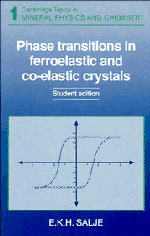Book contents
- Frontmatter
- Contents
- Errata
- Preface
- A brief guide for the reader
- 1 Introduction and some definitions
- 2 Ferroelastic and co-elastic phase transition
- 3 The Landau potential
- 4 The spontaneous strain
- 5 Coupling between the spontaneous strain and the order parameter
- 6 Macroscopic classification of ferroic and co-elastic crystals
- 7 Ferroelastic and co-elastic twin structures
- 8 Domain mobilities and elastic instabilities in ferroelastic and co-elastic materials
- 9 Specific heat anomalies and the excess entropy
- 10 Coupling between order parameters in ferroelastic and co-elastic crystals
- 11 Gradient coupling and strain modulations
- 12 Some aspects of the kinetic behaviour of ferroelastic and co-elastic crystals: an outlook
- References
- Appendix: An atomistic model for the Landau potential and the origins of the saturation effect
- Index
1 - Introduction and some definitions
Published online by Cambridge University Press: 03 May 2011
- Frontmatter
- Contents
- Errata
- Preface
- A brief guide for the reader
- 1 Introduction and some definitions
- 2 Ferroelastic and co-elastic phase transition
- 3 The Landau potential
- 4 The spontaneous strain
- 5 Coupling between the spontaneous strain and the order parameter
- 6 Macroscopic classification of ferroic and co-elastic crystals
- 7 Ferroelastic and co-elastic twin structures
- 8 Domain mobilities and elastic instabilities in ferroelastic and co-elastic materials
- 9 Specific heat anomalies and the excess entropy
- 10 Coupling between order parameters in ferroelastic and co-elastic crystals
- 11 Gradient coupling and strain modulations
- 12 Some aspects of the kinetic behaviour of ferroelastic and co-elastic crystals: an outlook
- References
- Appendix: An atomistic model for the Landau potential and the origins of the saturation effect
- Index
Summary
In the first chapter the basic phenomenological features of ferroelastic and coelastic crystals are summarised: i.e. twin structures, lattice distortions and the ferroelastic hysteresis. As some of the basic definitions are introduced here, even the knowledgeable reader should scan through this chapter - he or she might also enjoy the figures.
Many crystals, when observed under the optical microscope, display characteristic domain patterns. One of the most common microstructures is related to twinning, with dominant twin planes oriented approximately perpendicular to each other. Such twins have various origins and may arise from growth phenomena or transformation twinning. These twin structures are often seen to change when the crystals are squeezed or even only lightly touched with a preparation needle. This phenomena has, in particular, been the bane of structural crystallographers who found that single crystals spontaneously twinned during preparation for subsequent X-ray or neutron experiments. Mechanical twinning is not only observed in technologically important materials such as high Tc superconductors but is also commonly encountered in mineralogically and petrologically relevant systems, such as perovskites, boracites, palmierites, leucites, quartz and feldspars, to name but a few. Figure 1.1 shows a rather typical domain pattern in a crystal with a palmierite structure (Pb3 (PO4)2) which was induced by a gentle squeezing between the finger tips.
Observations of such effects have long been noted in the mineralogical community and their importance has certainly been recognized by eminent mineralogists, such as Laves (1969) who called these twins ‘Druckzwillinge’ (i.e. stress-twins).
- Type
- Chapter
- Information
- Publisher: Cambridge University PressPrint publication year: 1991



